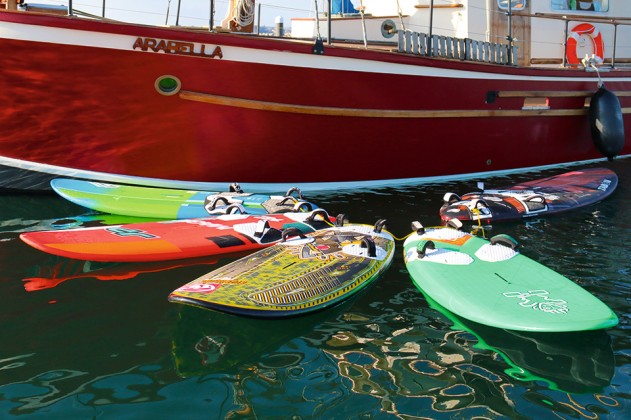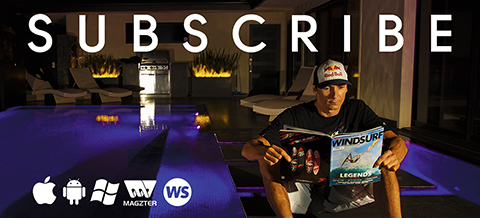SUMMER CRUISING
140L FREERIDE BOARD TEST 2016
Test Editor Tris Best // Second Testers Maurin Rottenwalbter & Joe North
Photos Tris Best // Test Location OTC, Portland, Dorset
There is a strong belief held by many that the large freeride board is the most important board class within the sport. It is often the first board bought by the aspiring novice sailor, having done a foundation start course at a windsurfing school, now keen to join the ‘rank and file’ of planing windsurfing. After all, it’s the sight of people whizzing across the water that inspired them to try the sport in the first place! The problem is that if the transition into planing winds is too great a hurdle, the influx of new blood into the sport will soon be severed and the industry as a whole will suffer as a result.
This test was originally published in the June 2016 issue.
So this ‘first time short board’ has therefore got a vital role to play within most windsurfing careers, making progression as pain free as possible. And let’s face it, once a newbie has finished their introductory course and invested in their own kit, it’s highly unlikely that they’ll ever take any structured course, clinic or one-to-one tuition again. They may hang onto a few tips from their newfound windsurfing friends (which may or may not be accurate!), read magazine technique articles or watch some of YouTube’s how-to videos; but there is no substitute for what they actually experience on the water. So the board and the rig purchased have to go it alone and make this volatile period as easy and rewarding as possible – no small task.
FINDINGS
The issue when testing large freerides is that all the frequent testers on our team (and, importantly, the brand’s R&D teams) have, not surprisingly, passed through this progression stage. Their attention, as with all advanced recreational sailors, is now likely to be focussed on beating their friends and peers across the water, leading product development down a misguided route. Fanatic Brand Manager, Craig Gertenbach, highlights this point in a recent email correspondence:
“For years the focus on the larger freeride boards was to win magazine tests / build in the most performance possible – we turned that around as an industry with the Gecko / RRD Firemove etc, making boards for the real world needs of sailors wanting to progress in their freeriding skills. … A good drag racer typically will not be that easy to gybe or plane, but again, is this what your average progressing windsurfer needs? Top end speed is interesting for slalom boards, freerace and to a lesser degree in bump and jump – unfortunately performance is also the most fun to test / one of the only things easy to quantify in a test, I know, been testing boards since 1987 … but I need to put my needs and that of my test partners away when we test these types of boards and think about the customer. The smaller sizes of the Gecko (133 and down) have more built in performance for freeride customers to access once their skills have developed.”
So what makes an easy progression platform? Well, firstly its qualities can easily been defined. It should be early to get going, with a low planing threshold so that the board cruises at a slow steady speed. It should also be easy to gybe, controllable and inspiring. Sounds straightforward, doesn’t it? Yet it is that last word that shrouds the design brief for the large freeride board in a cloud of uncertainty. ‘Inspiring’. What can be more inspiring than blasting along at speed and beating your mates? It’s a tough balance to get right; a sliding scale with no right or wrong answer. Should the progression board be a stepping stone to smaller boards, or can it remain in the quiver as your light wind option? Is easy progression mutually exclusive of blasting speed and performance?
Conducting this test at the centre and during this time of year presented the unique opportunity to gain a fuller understanding of these boards’ abilities by opening their use up to their intended audience – progressing sailors. During a scheduled Carve Gybe Clinic and frequent hire sessions, we could witness how the boards performed in a controlled environment, and help to confirm our findings. As a result, we believe the key to easy progression can be summed up in one word – stability. Stability, both in the board’s trim (largely influenced by its width), but more importantly in its direction, is fundamental in ensuring the smooth progression of the intermediate rider. So whilst width provides lateral stability, a longer, narrower board tends to track straight more effortlessly, demanding that a balance between the two be found. And whilst stability is paramount, can it be supplied in a package that also provides gybing ease, control and enough life to continue to inspire as the owner’s skills advance? We believe such a package is possible and there are some good examples within this group.
SUMMARY
Of the five boards here, the RRD is the most established design and can be credited very much with initiating the ‘wide-and-thin’ concept that has rejuvenated the direction in which large freeride boards have been developed. The widest here, it is an incredibly stable board laterally, can forgive clumsy footsteps and cruises comfortably over long distances. At the other end of the spectrum, the Tabou has almost freerace characteristics, being more technical to get planing and really only possessing outboard strap positions. At 87cm wide, it still provides a secure base underfoot, yet requires a more positive bear-off to make the most of its credentials – arguably within reach of the lighter or more proactive intermediate sailor. The Fanatic is a perfect tutor for the uninitiated, guiding even the most passive riding style seamlessly into planing wind strengths.
The Starboard is incredibly light in its new Carbon Ultracore construction, which undoubtedly helps its performance and feel on the water. Its riding style is unconventional, yet its appeal is broad, thanks to its ease and patience in marginal winds before its alter ego takes over as the wind increases. Then there is the JP– the newest design in the test line-up. At 81cm it is the narrowest in the group, yet has plenty of stability for all who tried it. As the wind comes in, it has an innate planing capacity, requiring little to no input from the rider. Yet, with its narrow thin tail, it did its name justice, feeling magical in the gybe and providing the feedback and feel that would keep even the most ardent rider engaged.
TEST LOCATION
This test was conducted at the Official Test Centre (OTC), on Portland, Dorset. The centre is based within the grounds of the National Sailing Academy that hosted the Olympic sailing classes in 2012. With the best wind stats on the south coast, mirror flat water in prevailing winds and a safe launch area with excellent facilities, it provides the ideal test venue. Much of the kit is still on site, so why not go and try some of it for yourself?
uk.otc-windsurf.com
THE LINE UP


